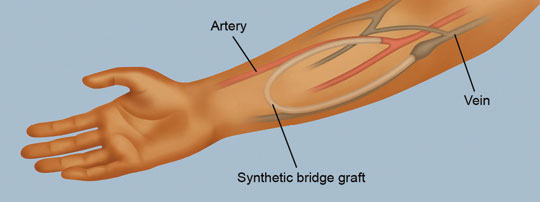
Choosing Your Best Dialysis Access

Types of dialysis access
For peritoneal dialysis access

Peritoneal dialysis catheter
Healing time after surgery: A few days to 2 weeks, depending on the urgency to start treatment. A PD catheter can also be placed in advance for a quick start when ready.
For hemodialysis access

Arteriovenous (AV) fistula
Healing time after surgery: 6-8 weeks to mature
Key considerations
- An AV fistula is the best choice for hemodialysis access if you're eligible.
- It's the most natural access site since it's formed from your own blood vessels.
- A fistula has the lowest chance of infection and clotting.

Graft
Healing time after surgery: 2-3 weeks
Key considerations
- A graft is a great alternative if your veins are too small or weak for a fistula.
- It offers better blood flow and has a lower risk of infection than an HD catheter.
- A graft may be replaceable with a fistula if veins get stronger or bigger after being on dialysis.

Hemodialysis catheter
Healing time after surgery: Ready for immediate use after placement—not recommended unless medically necessary
Key considerations
- A hemodialysis catheter is often used temporarily until a permanent graft or fistula is ready for use.
- It has a higher risk of infection and clotting due to the catheter tip's location being near the heart.
- A hemodialysis catheter must be kept dry, which can limit bathing options.

Caring for your access is key
The basics of caring for your access site:
- Practice good hygiene—clean or sanitize your hands and wear a mask for at-home treatment.
- Check for infection—inspect your access site for changes in appearance.
- Protect your site—avoid clothing that rubs or sleeping positions that irritate your access.
- Talk to your nurse—if there's an issue or a question, act fast to avoid complications.
There are several treatment options when kidneys fail during ESRD. Discuss all the choices with your doctor to determine what's right for you.

Making sure you have the best access type for you
If you're going to start hemodialysis, an AV fistula is the best access type if you have adequate vein strength and size. A graft is also a great choice if you're unable to get a fistula.
Vein mapping is an important first step.Getting a painless, noninvasive vein-mapping test helps your doctor assess the condition of your veins and determine which type of access will work best for you. Ask your doctor about the test if you haven't had one already.
Switching access types may be an option.If you currently have a hemodialysis catheter and you're medically able to have another type of access, talk to your doctor right away about switching to a preferable option.
If you currently have a graft, your vein strength and size may increase once you're on dialysis—making a fistula a possibility.
Ask your doctor about vein mapping and learn about your access choices.
